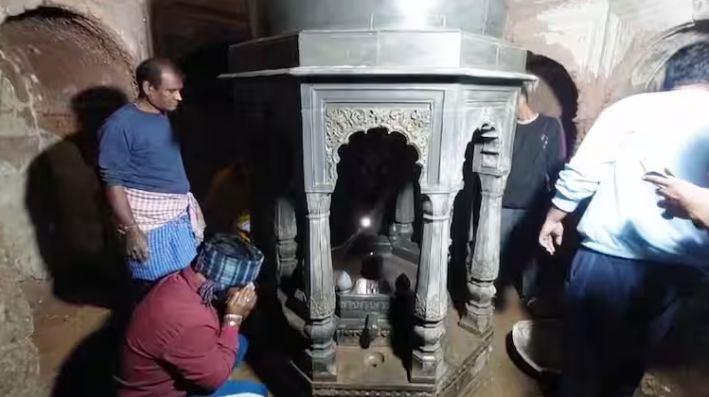बिहार के पटना शहर में हाल ही में आलमगंज इलाके में जमीन धंसने के बाद 500 साल पुराना शिव मंदिर मिला है। यह घटना अप्रत्याशित रूप से हुई जब जमीन का एक हिस्सा धंस गया, जिससे वार्ड नंबर 54 में लंबे समय से कूड़े के ढेर के नीचे प्राचीन मंदिर का पता चला।
खोज का मुख्य विवरण:
मंदिर की संरचना:
खुदाई में एक शिवलिंग (भगवान शिव का एक पवित्र प्रतीक) और प्राचीन पैरों के निशान मिले हैं, जिन्हें सदियों से संरक्षित किया गया है।
संरचना सैकड़ों वर्षों से भूमिगत छिपी हुई प्रतीत होती है, संभवतः प्राकृतिक अवसादन या मानवीय उपेक्षा के कारण।
ऐतिहासिक महत्व:
प्रारंभिक अनुमानों से पता चलता है कि मंदिर लगभग 500 साल पुराना है, उस समय का है जब पटना, जिसे ऐतिहासिक रूप से पाटलिपुत्र के नाम से जाना जाता था, एक महत्वपूर्ण सांस्कृतिक और धार्मिक केंद्र था।
विशेषज्ञों का मानना है कि मंदिर को सदियों से बाढ़ या शहरी विस्तार के दौरान छोड़ दिया गया होगा या दफन कर दिया गया होगा।
सार्वजनिक प्रतिक्रिया:
इस खोज ने भक्तों और उत्सुक दर्शकों की भारी भीड़ को आकर्षित किया है। आस-पास के इलाकों से लोग प्रार्थना करने और प्राचीन अवशेषों को देखने के लिए एकत्र हुए हैं।
यह स्थल जल्दी ही धार्मिक उत्साह का केंद्र बन गया है, कई लोग इस खोज को दैवीय आशीर्वाद मानते हैं।
अधिकारियों की प्रतिक्रिया:
स्थानीय अधिकारियों ने बड़ी भीड़ को नियंत्रित करने और सुरक्षा सुनिश्चित करने के लिए क्षेत्र की घेराबंदी कर दी है।
इस स्थल का अध्ययन करने और इसके ऐतिहासिक और स्थापत्य महत्व की पुष्टि करने के लिए भारतीय पुरातत्व सर्वेक्षण (एएसआई) को शामिल करने के प्रयास चल रहे हैं।
भविष्य की पीढ़ियों के लिए मंदिर को संरक्षित और पुनर्स्थापित करने की योजनाओं पर चर्चा कीया जा रही है।
धार्मिक महत्व:
मंदिर की खोज ने आध्यात्मिक उत्साह को जगाया है, भक्त विशेष अनुष्ठान कर रहे हैं और प्रार्थना कर रहे हैं।
कई लोगों का मानना है कि शिवलिंग और मंदिर का उद्भव दैवीय हस्तक्षेप का संकेत है, जिससे स्थानीय समुदाय में आस्था मजबूत हुई है।
अगले कदम:
पुरातत्वविदों और इतिहासकारों से मंदिर की उत्पत्ति, स्थापत्य शैली और ऐतिहासिक संदर्भ को समझने के लिए विस्तृत अध्ययन करने की अपेक्षा की जाती है।
संरचना को और अधिक नुकसान से बचाने के लिए संरक्षण प्रयास शुरू किए जाने की संभावना है।
सांस्कृतिक संदर्भ:
शिव मंदिरों का हिंदू धर्म में बहुत अधिक धार्मिक महत्व है, जो ब्रह्मांड के निर्माता और संहारक के रूप में भगवान शिव की भूमिका का प्रतीक है। इस तरह के प्राचीन मंदिर की खोज इस क्षेत्र की समृद्ध आध्यात्मिक और ऐतिहासिक विरासत को उजागर करती है।
यह उल्लेखनीय खोज न केवल अतीत की झलक दिखाती है, बल्कि भारत के प्राचीन सांस्कृतिक और धार्मिक स्थलों को संरक्षित करने के महत्व को भी पुष्ट करती है।
A 500-year-old Shiva temple has been found after a recent land subsidence in Alamganj area in Patna city of Bihar. The incident happened unexpectedly when a portion of the ground caved in, revealing the ancient temple under a long-since dumped garbage dump in ward number 54.
Key details of the discovery:
Temple structure:
The excavation has unearthed a shivling (a sacred symbol of Lord Shiva) and ancient footprints, which have been preserved for centuries.
The structure appears to have been hidden underground for hundreds of years, possibly due to natural sedimentation or human neglect.
Historical significance:
Initial estimates suggest that the temple is about 500 years old, dating back to the time when Patna, historically known as Pataliputra, was an important cultural and religious center.
Experts believe the temple may have been abandoned or buried during floods or urban expansion over the centuries.
Public response:
The discovery has attracted a massive crowd of devotees and curious onlookers. People from nearby areas have gathered to pray and see the ancient remains.
The site has quickly become a centre of religious fervour, with many considering the discovery a divine blessing.
Officials’ response:
Local authorities have cordoned off the area to control the large crowds and ensure safety.
Efforts are underway to involve the Archaeological Survey of India (ASI) to study the site and confirm its historical and architectural significance.
Plans to preserve and restore the temple for future generations are being discussed.
Religious significance:
The discovery of the temple has sparked spiritual fervour, with devotees performing special rituals and offering prayers.
Many believe that the emergence of the Shivalinga and the temple is a sign of divine intervention, strengthening faith in the local community.
Next steps:
Archaeologists and historians are expected to conduct a detailed study to understand the origin, architectural style and historical context of the temple.
Conservation efforts are likely to be initiated to protect the structure from further damage.
Cultural context:
Shiva temples hold immense religious significance in Hinduism, symbolizing Lord Shiva’s role as the creator and destroyer of the universe. The discovery of such an ancient temple highlights the rich spiritual and historical heritage of the region.
This remarkable discovery not only offers a glimpse into the past but also reinforces the importance of preserving India’s ancient cultural and religious sites.






